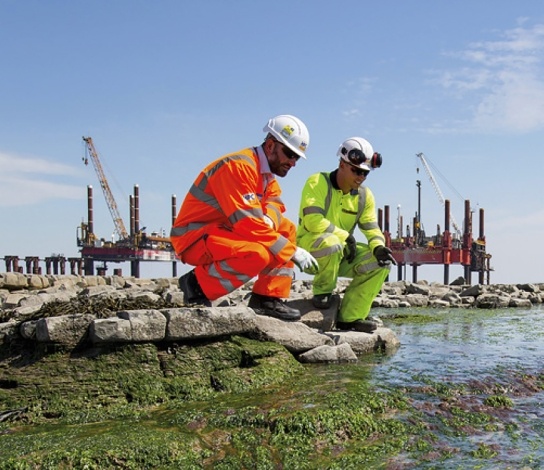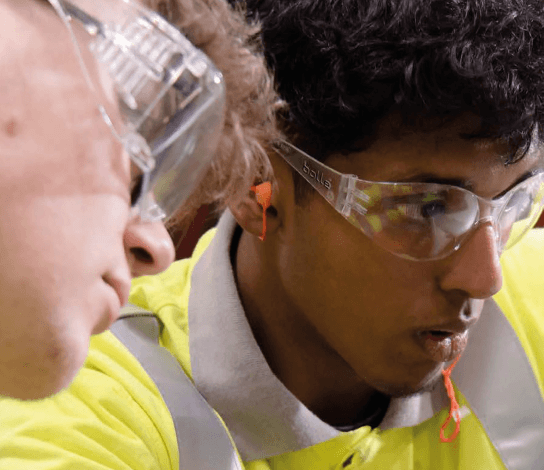Generating zero carbon electricity
In April 2023, we achieved our goal to reduce carbon intensity at the point of generation to 0g CO2e/MWh. This followed the closure of the last 2 units of our West Burton A coal plant in March 2023.
We now generate 100% zero carbon electricity from wind farms and nuclear plants.
Direct combustion intensity of our electricity generation
Our goals
By 2035, we aim to enable over £50 billion of investment into the UK, the equivalent to nearly £1,750 per household, developing 15GW of zero carbon electricity. That’s around 20% of the current energy needs in the UK.
A planned £4.5 billion will be invested in 2023, building and maintaining Britain's nuclear and renewables generators.
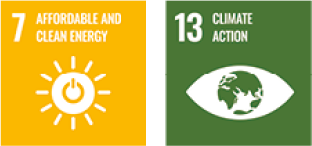
Renewables & storage
Through EDF Renewables UK, we have an operating portfolio of 1GW of battery, onshore and offshore wind, and are expanding our portfolio to over 8GW of projects in construction, planning and development, including wind, battery and solar.
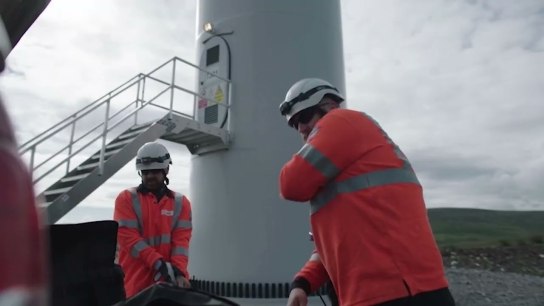
Onshore wind
- We operate more than 30 onshore wind farms in the UK.
- In 2022, we completed the construction of the 30MW West Benhar wind farm.
- Our largest onshore wind farm in Europe is the 177MW Dorenell farm in Scotland, providing power for around 106,000 homes since 2019.
Offshore wind
- We have two operational offshore wind farms in England: the 62MW Teesside farm and 41.5MW Blyth farm.
- We are building the 450MW Neart na Gaoithe offshore wind farm that will have the potential to supply around 375,000 Scottish homes from 2024.
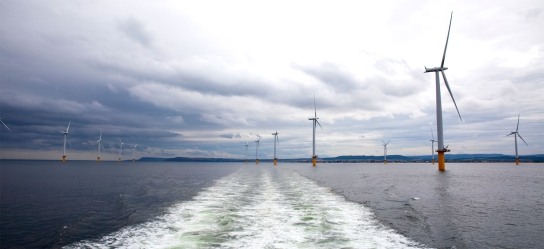
Solar
We are building solar farms with 50MW Porth Wen farm, 50MW Sutton Bridge farm, and 50MW Burwell farm expected to go live in 2023. Each will be capable of generating enough low-carbon electricity for more than 9,000 households annually, saving around 21,000 tonnes of CO2.
Batteries
- We are enhancing the flexibility of the electricity system by developing Energy Superhubs, which combine large-scale batteries and high-volume power connections to enable rapid EV charging.
- In 2022, we activated a cutting-edge hybrid battery near Oxford combining a 50MW/50MWh lithium-ion battery with a 2MW/5MWh vanadium flow battery. The battery provides flexibility to the grid by storing energy at times of high supply and discharging electricity when the sun doesn’t shine or the wind doesn’t blow.
- We will bring online two more battery sites in Bustlehome and Coventry.
- We signed a repeat order with technology group Wärtsilä to deliver our sixth battery storage project, which will be a 57MW/11MWh grid-scale facility in Suffolk.
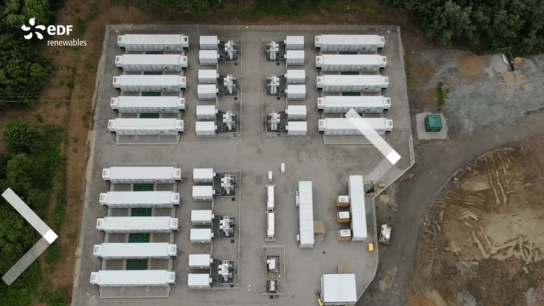
Hybrid
We are developing our first multi-technology renewable energy project in South Wales, Hirfynydd Renewable Energy Park. This hybrid project would include up to seven turbines, a solar array and battery storage and have an installed capacity of 100MW, capable of generating electricity for more than 37,500 households.
Nuclear
We are supporting the ambition of the UK Government to deliver new and advanced nuclear power to help meet projected electricity demand by:
- Operating five nuclear plants: Sizewell B, Hartlepool, Torness, Heysham 1 and 2
- Defuelling all AGR power stations, with Dungeness B, Hunterston B and Hinkley Point B currently in defueling phase
- Building a 3.2GW European Pressurised Water Reactor (EPR) at Hinkley Point C in Somerset
- Developing a replica 3.2GW EPR project at Sizewell C in Suffolk
- Working on extending the operational life of Sizewell B by at least 20 years, from 2035 to 2055
- Supporting the wider UK new nuclear programme with skills and sites to explore new nuclear technologies
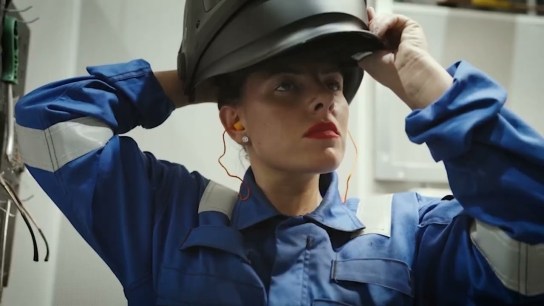
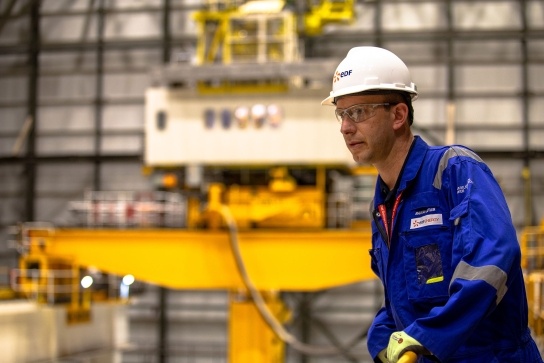
Together Sizewell B, Sizewell C and Hinkley Point C could deliver reliable low-carbon power for more than 15 million homes.
We are committed to ensuring nuclear excellence, preserving and developing technical skills and capabilities, and sustaining safe, reliable and commercially viable operations.
How nuclear can help Britain achieve Net Zero and energy security
Nuclear plants can help stabilise and reduce energy costs in the long term, generating low-carbon electricity and limiting the indirect costs of climate change. Despite the large capital costs needed for construction, once operating nuclear plants provide large and stable low-carbon electricity supply over long lifetimes, resulting in low marginal costs. Nuclear plants do not rely on volatile or intermittent energy sources, contributing to the stability of power grids and minimising the indirect costs of energy shortage and contributing to energy security.
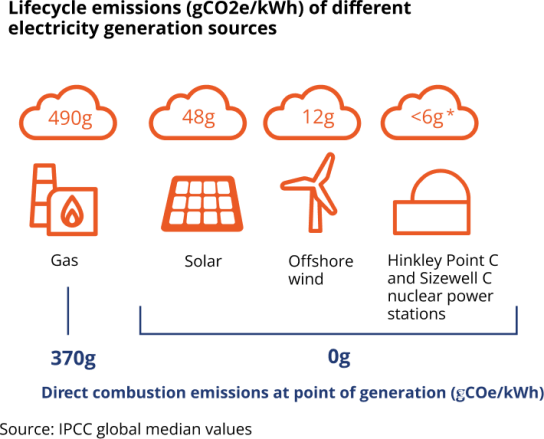
Nuclear has zero direct combustion emissions. Even emissions from the lifecycle of nuclear plants, from construction, operations, fuel production to decommissioning, are much lower than gas, solar and wind. This has been demonstrated through lifecycle carbon assessments (LCAs) of Sizewell C, Hinkley Point C, Sizewell B and Torness.
Hinkley Point C
Construction is progressing. The offshore work to install components for the cooling system moved into the final stages with the arrival of the vessels to install the shafts. The first new nuclear reactor arrived in Somerset in February 2023 and will be installed in the reactor building after the dome is lifted into place.
Sizewell C
The UK Government announced in 2022 that it will be investing £679 million in the Sizewell C project, becoming a 50% shareholder with EDF. Early work across the Sizewell estate is continuing to prepare the site for construction of the new power station, which is anticipated to start in 2024.
Heysham 1 and Hartlepool extension
We announced in March the plan to extend the lifetime of Heysham 1 and Hartlepool power stations by 2 extra years to 2026. Heysham 1, in Lancashire, and Hartlepool, in Teesside both mark 40 years of generation this year. The decision has been made after a rigorous review of the technical and commercial cases for life extension. In particular, positive inspections of the graphite reactor cores during 2022 have increased confidence that the stations can generate for longer and continue to meet stringent regulatory standards. The additional 29TWh of electricity these stations could generate over that 2-year period could help to displace 6 billion cubic metres of gas. The carbon avoided from this displacement is 10 million tonnes, like taking 5 million cars off the UK’s roads for a year.
Innovation
We are applying new technologies and ways of working to help Britain achieve Net Zero. Research and development and innovation can accelerate our transition to Net Zero. Our researchers, engineers and innovators are leaders in their fields and work with diverse partners to find solutions.
Bay Hydrogen Hub
We are developing an innovative technology that uses nuclear generated heat and electricity to create hydrogen for asphalt and cement sites. This project is a key step towards the decarbonisation of the asphalt and cement industries, developing nuclear enabled hydrogen production and investigating technologies to deliver hydrogen to dispersed industrial sites. The project received government funding for an initial feasibility study with the aim of demonstrating the technology at the megawatt scale by 2025. This shows the value of EDF’s integrated approach, with nuclear-enabled Hydrogen supporting Hanson, a major industrial customer, to decarbonise.
HyDUS (Hydrogen in Depleted Uranium Storage)
We are part of a consortium to develop an innovative hydrogen storage demonstrator. Under this technology, hydrogen is absorbed on a depleted uranium ‘bed’, which can then release the hydrogen when needed for use. New technologies are needed to store energy for long periods when low-carbon generation sources are producing excess energy.
Tees Green hydrogen
Our Tees Green hydrogen project has been shortlisted for the government’s Net Zero Hydrogen Fund. It will use green electricity from our nearby Teesside offshore wind farm and a planned new solar farm, to power its hydrogen electrolyser and supply local businesses with green hydrogen.
Sizewell C Clean Energy Hub
Sizewell C can help kickstart other net zero technologies such as hydrogen production and direct air capture (DAC). Nuclear is a great way of producing low-carbon hydrogen as it generates low-carbon electricity and heat. Sizewell C is also part of a consortium which has been awarded government funding to carry out a design study on powering DAC using heat.
Prototype fusion at West Burton A
Our West Burton A site will host the UK’s first prototype fusion energy power plant. Andy Powell, EDF’s Plant Manager for West Burton, said: “Moving from fossil to fusion technology is an exciting prospect that connects directly to the company’s purpose, to Help Britain Achieve Net Zero. This scheme will also secure jobs in the local area for decades to come.”
AMR at Hartlepool
Our proposal to develop an Advanced Modular Reactor (AMR) at Hartlepool has won almost half a million pounds of funding to further explore the concept as part of BEIS funded AMR Research, Development and Demonstration (RD&D) programme. Independent studies commissioned by BEIS have also identified Hartlepool as the best site in the UK for an AMR demonstrator plant.
Discover more
Find out how we're helping Britain achieve Net Zero

